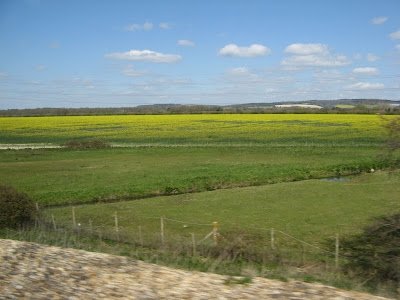Yesterday I needed to get away.
I find empty trains soothing. Just the gentle sway of coaches, the occasional clack rattling down the train, the rush of wind, and three other people similarly entranced by landscape slipping away. Occasionally the recorded lady announcing a new station.
Swanwich
Fareham
Porchester
Cosham
This is coach number two of four.
In my bag is a jersey, an umbrella and sandwiches for lunch. Two apples, water and a bottle of beer. Two cameras, one for documentation, one for calibration. Lonely planet. And Ward Lock & Co's Red Guide to Southsea and Portsmouth, from the postwar 40s I believe. It comes with a map detailing the route from Southampton to Chichester, a solid black line skimming just north of the coast. I don't think the railroad has shifted much in 60 years. The A27 was just a road then. The map holds that smell of an old library: paper approaching middle age. Only the water is coloured. Blue. Tiny trees make up forests, towns are small blocks that might still refer to houses, warehouses and sheds.
Havant.
I wonder what happens in Havant?
Emsworth.
It is a day that requires distance. Changing spaces, strange faces. Walking, seeing, writing, being. Thinking, unencumbered. The train helps with that. My mind is busy at first, jumping, running. Then comes the blankness. Then the peace.
Chichester
Lunchtime has an organ recital in the cathedral. The scheduled organist cancelled due to ash, so the local Assistant steps in. I feel 40 years younger than anyone in the audience. Creaking men can't sneak out quietly.
I try to recall the architectural terms to remember the building by. The building is Romanesque at heart, but with the inevitable updates over 900 years that make it so interesting. The aisles slip into early Gothic, with more Victorian ornament stuck on top. The stained glass is mostly Victorian too: young and still bright, dappling light on the floor.
A violently bright tapestry by John Piper adorns the high altar - it must have led too weeks of angry letters from outraged residents. A window by Chagall hides in a corner. It is less blue than I expected. Menstruation, someone said.
In the north aisle lies the Arundel Tomb - the earl and his wife. They are holding hands. Philip Larkin noticed it too.
When I emerge into the light again it's too late to rush to the Roman mosaics at Fishbourne. So I slowly explore the town. Shippams has turned into New Look, while Next trades from the Corn Exchange. A building where Keats used to play is a barber shop. And the Roman Amphitheatre is a slightly uneven lawn, today with three boys battling with bat and ball. Yet it remains a pleasant place. With Georgian houses, tea rooms and stores where Conservatives can shops. Pleasant.
A pint, then home.






No comments:
Post a Comment